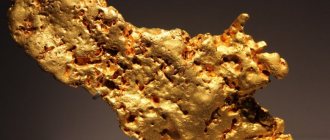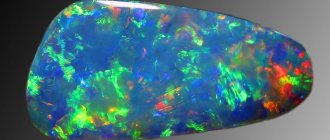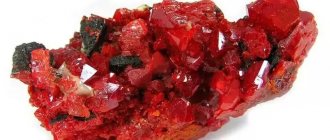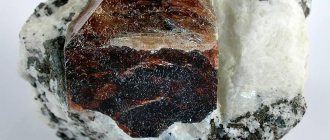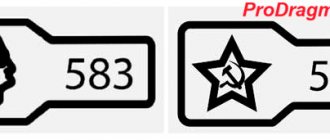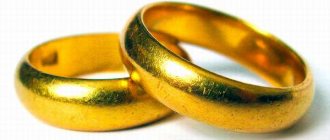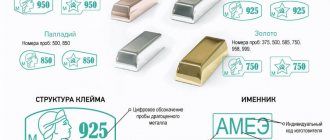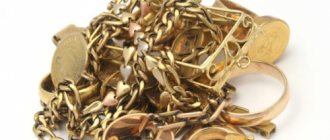The hallmark of gold and silver is a special mark that helps determine the amount of precious metal in the alloy. It is noteworthy that initially in Rus' only silver was hallmarked, but at the beginning of the 18th century gold was also hallmarked. There are several hallmark systems; previously, a special mark was placed on silver or gold. It contained information not only about the amount of precious metal in the ligature, but also about the craftsman who made the jewelry.
Ring test
What is gold purity
Gold is a metal with incredible ductility and toughness, and at the same time low strength. In its pure form, it is of little use for making jewelry, so components that “strengthen” it, the so-called, are added to pure noble metal. ligature. Depending on the desired color, it can be copper, silver, platinum, palladium and some other metals. The hallmark, or state hallmark, is a special sign that certifies the percentage of precious metal in a piece of jewelry.
What is a ligature
Gold has been admired since time immemorial; it was called both fragments of the sun and a gift of the gods. However, in its original form this metal looks completely unimpressive. Pure Aurum has nothing in common with the noble metal; it has a bunch of disadvantages:
- susceptible to corrosion;
- easily susceptible to any mechanical damage;
- has a dull and inexpressive color.
Products made from such material could hardly be considered a model of perfection. And they certainly would not have been able to fit into the family category; their life would have been too short.
Without “strengthening” impurities, gold is not suitable for the work of jewelers.
They were able to correct the situation by mixing gold with slightly less noble silver or even cheaper copper. Often the “recipe” for high-quality gold involves the addition of palladium and zinc.
By combining them in different proportions, people have learned not only to create ideal alloys for making gold products, but also to give them different shades. Today, not only metal of the classic yellow color is popular. Ladies are happy to wear white, dark, pinkish and even emerald shades.
Alloys that “strengthen” gold and give it complete beauty are called alloys. Its final price depends on the ratio of the noble metal and impurities. The most expensive is the one that is almost pure Au. Financiers respect him. But jewelers don’t like it at all. They have their own idea of what standard of gold guarantees the best result.
Sample systems
The hallmark is placed not only on gold jewelry, but also on bank bullion. But gold medals, orders and coins are not branded, although the precious metal content in them is strictly regulated and subject to control. To understand what standard gold is, you need to decide on the counting system used.
What are the sampling systems?
- Carat. Pure gold is defined as 24 karat. Jewelry can be 6, 8, 10, 12, 14, 18 and 22 carat. Our 585 corresponds to 14-karat, 750 - 18-karat. For example, 14 karat means that there are 14 parts of Au in 24 parts of the alloy.
- Metric. Everything is simple here. The percentage content is reflected in the number, in thousandths: 585 sample is 58.5% of the precious metal in the alloy, 750 is 75%.
- Spool valve, obsolete. In the old days, a spool (digital) sample system was used in Rus'. It indicated how much pure Au was in the alloy. 1 spool equaled 4.25 g, and there were 96 spools in a pound. The hallmarks of that time were 36, 48, 56, 72, 82, 92, 94. For example, if we talked about 72 hallmark gold, this meant that 1 pound of the alloy contained 72 spools of pure metal.
The carat system originates from Great Britain, and therefore the term “British carat” is often used. It is applicable in Switzerland, Turkey, USA, Canada, Spain. The metric system operates in the territory of the former USSR, in Italy.
What standard is pure gold?
In the carat system it is designated as 24 carat, in the metric system it is designated as 999.9. Why is there no 1000 sample? You won’t see this even on a bank bullion. The highest possible in reality is 999.9, this is the so-called. bank gold, although liberties are allowed in the karat system, the bar indicates 24 carats, that is, absolutely pure metal. The carat, which is used to measure the purity of gold, and the carat, which is used to measure the weight of precious stones, are fundamentally different units of measurement. The first one in English is written karat and means a share, the second one is carat and means a unit of weight of 0.2 grams.
A little history
Gold and silver have always been in demand; these metals were expensive and were used not only for making jewelry, but also for minting coins. Initially, the mark was invented as a way of protection against fraudsters who masterfully counterfeited coins.
For this reason, the first samples appeared on silver, and not on gold, since this metal was used for minting coins. Later, gold was also branded; this happened around 1700. At the same time, the marking did not contain any additional information; it only indicated that the metal complied with the standard. But what can be considered a standard was not specified. But still, the appearance of the hallmark helped reduce the number of counterfeit coins.
Later the standard was replaced. Special marks began to be applied to jewelry, which could tell about the amount of precious metal in the product, the maker and the weight of the jewelry. This helped determine the quality of jewelry, their specific weight and increase the prestige of some jewelers.
This system did not last long and was later replaced again. Now the state controlled the quality of jewelry, coins and other products made of gold and silver. The stamp had an image of a girl in a kokoshnik, and a carat sample was also applied to the surface of the jewelry.
Structure of the hallmark
The carat system was replaced by the metric system, this happened in 1927, it was then that the Soviet authorities decided to change the image of the girl in the kokoshnik. Instead of a girl’s profile, an image of a male collective farmer appeared, and then a hammer and sickle began to be applied to the products. Naturally, after the collapse of the USSR, a decision was made to change the stigma.
Today, on the surface of the jewelry you can again see the profile of a girl in a kokoshnik and the corresponding metrics. The numbers will tell you about the amount of precious metal in the ligature, and the girl’s profile acts as a guarantor of quality.
According to the legislation of our country, markings should be applied to all products that contain at least 30% precious metal. Everything else is impurities that can change the properties of gold and silver, making the alloy more suitable for the jewelry industry.
The mark is placed not only on silver and gold, it can be found on products made from the following metals:
- platinum;
- palladium
All other metals are not classified as precious; for this reason, markings are not placed on their surface.
Russian gold standard: what are they, stamp
What standard is gold in Russia? Our country uses the metric system. In addition to the well-known 585 and 750, there are several more standards established by the state. They can be used not only in the jewelry industry, but also in arts and crafts, dentistry, and manufacturing.
What types of gold are there in Russia:
- 585 is the most popular standard of gold in jewelry in Russia. Perfectly holds the shape of even the most sophisticated jewelry. Practical and inexpensive. Perfect for jewelry that is worn every day.
- 750 – prestigious. Due to the higher precious metal content, it is more expensive, less practical, more ductile, and therefore, as a rule, is used for premium jewelry.
- 999 is a banking brick, investment gold that can be cut with a knife. Jewelry made from such metal quickly wears out, although the wedding rings of many members of the imperial family in Russia were made of pure 999 gold.
- 958 - in Russia it is usually used for making gold leaf, i.e. the thinnest plates of precious metal that become a decorative coating.
- 500 - used for gilding, making cufflinks, brooches, pens, in addition, many foreign-made jewelry that are declared as 14-carat (585), but do not reach the required Au content, receive this mark.
- 375 is a dull, unattractive metal, used for making watches, cigarette cases, church utensils and other household items.
It is not easy to produce an alloy with the exact percentage of Au, which is why there is a remedium for each sample. This term means the maximum permissible deviation from the standard.
White gold ring with diamonds and sapphires 911293SB
This model is made to order
Which gold is better - Soviet or Russian?
Previously, the trees were taller, the skies were clearer, and the gold was better. This is exactly what many of our compatriots think. Is it so? In the USSR, the 583 standard was used, in 2000 it was replaced by the modern 585. Which gold is better, 583 or 585? It would seem that the difference is small - only 0.2%. But…
Remedium in the USSR was defined as 3 units, the percentage of noble metal required for stamping ranged from 58 to 58.6. Russian 585 standard can only have a positive remedium of 5 units, that is, the percentage of precious metal in it is from 58.5 to 59%. The difference in actual gold content can reach 1%. In addition, 585 metal is recognized by jewelers all over the world; it meets international quality standards.
In the USSR, the state established what types of gold there were and their prices. In the Russian Federation, the state establishes only a list of samples, but the price of gold is market price and is generally oriented towards the exchange rate of the precious metal. It may differ from one manufacturer to another. The final price of jewelry is influenced not only by the percentage of gold content in the metal, but also by manufacturing technology, the presence of inserts, serial number, and brand.
What standard is gold for coins?
You can often come across the opinion that gold coins are cast from pure gold. The material for coins is called red gold, i.e. the one from which gold chervonets were made. Even on Wikipedia for a long time one could read the statement that red gold is “the purest gold.” Indeed, the metal for coins had a higher content of noble metal, and yet its percentage was only 90%. So he is far from banking.
White gold ring with diamonds 921439B
This model is made to order
Where to find an hallmark on gold jewelry
The numbers on the stamp near the “girl in a kokoshnik” icon are the required designation of the pure gold content. Next to this mark there is another one - this is the name tag, which contains information about the plant in encrypted form. In order not to spoil the appearance of the jewelry, the mark is placed in the most inconspicuous place:
- on the ring - inside the rim;
- on the pendant - from the wrong side;
- on earrings - on a shvenze, on studs - on a pin;
- on chains and bracelets - on a link near the lock.
From 2021, it is planned to introduce another tag - a QR code nanotag, with the help of which the state will be able to monitor the circulation of precious metals even more closely. True, these marks will be invisible to the buyer.
Which sample can be considered the best?
In Russian there is a figurative expression - “gold of the highest standard.” This is how they talk about something superlatively beautiful and expensive. Although, as you can see from the information above, it is pure gold that is not suitable for anything other than lying in a safe deposit box. So it’s probably impossible to say with certainty which standard of gold is better. Each option has its undeniable advantages. As well as the shortcomings.
Let us only note that alloys marked “585” and “750” are more suitable for jewelry production. Things made from them can be stored for a very long time and, in the end, even acquire the status of heirlooms.
For investing money, the best ingot is the one with the most expensive purity of 999 on it. The price for it is quite stable; in recent years there have been only minor fluctuations. So this metal can guarantee the safety of capital.
Who tests
Each country determines its own sampling system, this indicator is guaranteed by the state. In Russia, the sample is applied not by the manufacturer, but by a government agency - the Assay Chamber. The first law on mandatory hallmarking of gold items in Russia was issued in 1700. And today, all jewelry produced in the Russian Federation must comply with the standards established by law, that is, it will not be possible to make a ring containing gold to your taste, even if you ordered it from a jeweler in a single copy. The master will turn a deaf ear to the request “add more gold”...
Is sampling a guarantee of quality?
On the territory of our country, it is almost impossible to buy gold of a low standard or a counterfeit of a precious metal with a hallmark (unless, of course, you decide to purchase it second-hand or in a dubious establishment), since the circulation of precious metals is under close control.
Not all countries carry out testing by a government agency. For example, in Turkey the brand is put by the manufacturer himself. Hence the numerous problems with authenticity. Moreover, if Turkish gold is sold in Russia, you can be sure that the declared share of the precious metal corresponds: before it reaches the counter, imported jewelry is sent to the Russian Assay Office, which is part of the Ministry of Finance.
How is the authenticity of precious metals determined?
When accepting a pledge and buying it at a pawnshop, a specialist checks the authenticity of precious metals using chemical reagents. They help to identify the content of precious metals in the alloy. The standard can be any: carat, spool, metric.
Methods for verifying the authenticity of precious materials
Products are tested at enterprises that monitor whether their quality meets established standards. Only after such verification is the mark of the corresponding sample applied. The testing methods there do not affect the appearance of the product and its composition.
Let's consider what verification methods can be used at jewelry factories, workshops, retail enterprises and institutions that issue loans secured by jewelry, pawnshops.
Touchstone
Touchstone - siliceous shale (contains 8% carbon, therefore black) for quick analysis of the authenticity of precious metals. The stone must have a smooth, fine-grained surface and chemical resistance to acids. There are no cracks, scratches, or heterogeneity. The stone can be of natural or artificial origin.
This method does not damage the integrity of the product, is easy to use and is suitable for determining any type of alloy.
Prepare the stone for testing by rubbing it with castor oil. Then “rubs” are made on it with the product - strips 15-20 mm long and 2-3 mm wide. Stripes are applied nearby with standard needles and then the whole thing is moistened with the required reagent. After the required exposure time, the reagent is removed with a blotter/filter paper and the precipitation is compared.
Assay needles
These are strips of alloys that correspond to a certain composition of the material and the presence of alloy components. The more materials included in the sample standard, the more complete the set of needles.
Image source https://stalstroyservis.ru/
Using a determinant
The 585 sample can be confirmed using a digital portable detector: in a few seconds the device will establish the content of the composition from 6 to 18 carats.
Image source https://jewelermarket.ru/
Reagents for sample verification
Preparation
The product is cleaned because it may be coated with a higher grade precious metal or a layer of dirt, grease, oxide film or colorless varnish. Clean the product using a special tool: a finely notched needle file or scraper.
Pawn scraper - a tool for cleaning products Image source https://jewelermarket.ru/
The appraiser should remember that items of historical and artistic value can be brought to a pawnshop. In such cases, the check must be carried out carefully with a scraper, not from the front side.
Reagent testing
Drip method
determining the amount of precious metal in the alloy: the surface of the product is cleaned, a reagent is dripped onto it. Assay reagents are produced by Assay Supervision Inspectors.
When using reagents, avoid contact with skin and mucous membranes. Use reagents at room temperature. You need to store them:
- with a sticker indicating the purpose of the reagent,
- in pencil cases with recesses for bottles,
- in a cool and dark place without moisture,
- away from household appliances and other metal surfaces.
A precipitate should not form; reagents must be changed if it appears (after 2-3 months for high-grade gold, after 6 months for other reagents).
Image source 1nerudnyi.ru
What reagents are used:
- Gold chloride solution
– for gold up to 600 samples.
The use of gold chloride makes it possible to identify a wide range of alloys, establishing the presence of a fraction of gold in the composition of the material according to the degree of oxidation and color saturation. An experienced specialist can use gold chloride to identify silver among other white metals. The lower the gold grade, the richer the color of the stain. The product of sample 999-585 does not interact with the reagent; on sample 583 it will leave a weak, barely noticeable trace.
- Acid reagents for gold
750, 900 and 958 samples.
Pure nitric acid is the most common way to determine a sample below 583. In this case, a reaction occurs with the release of gas: the lower the gold content, the more intense bubbles are released under a drop of acid.
The action of acid reagents determines gold samples from 333 to 900.
The sequence of testing gold with an acid reagent:
– rub a small sample of the product on a special stone mechanically,
– apply the reagent to the material with a glass rod,
– compare the result of a chemical reaction and established standards.
- Potassium dichromate solution (chrompic)
for silver not lower than 600 standard.
Under its influence, a dark brown-red sediment will remain on 600 silver. As the sample increases, the brightness of the spot increases:
- 780-820 sample – orange color,
- 875 standard – red color,
- above 900 standard – bright red, bloody.
- Silver nitrate solutions
for silver 500, 750, 800, 875, 916, 925, 960 samples.
In this case, a weak gray-white coating is formed, the saturation of which, as the sample decreases, intensifies to an ash-gray hue.
- Potassium iodide solution
for platinum and alloys with high precious metal content.
Using this solution, counterfeit metals that are resistant to other reagents are identified. It does not work on alloys that start at 900 fineness. 800 fineness items and highly chemical resistant jewelry will show a green/black stain with possible bubbling.
- Acid reagent for the 958th sample
for gold alloys.
The quantitative composition of gold in the alloy is determined by the color of the reaction. If the gold darkens during the reaction, it means it has a lower purity than 958.
Checking gold items
After cleaning, a drop of gold chloride
, the sample and metal of the product are determined:
- for rose gold:
- 585 sample after 10-15 seconds there will be a faint light spot or there will be none,
- 500 sample after 5-7 seconds - chestnut spot;
- 583 or 585 samples with nickel in the composition - an orange-golden spot,
- 583 or 585 samples with palladium in the composition - a pale brown spot;
- 375 sample - after 1-2 seconds a brown spot will appear, and then a dark green one,
- 333 samples, a brown-green spot will appear instantly.
Checking silver items
A solution of potassium dichromate (chrompic) is used on the cleaned product, which acquires different shades of red:
- 600 silver is brown/dark brown;
- 780-820 samples - brown shades turn into red-orange;
- 875 samples – red;
- above 900 standard – dark red;
- below 600 sample the reaction stops.
Silver alloys of 500, 750, 800, 875, 916, 925, 960 samples are tested using silver nitrate solutions. In this case, a gray-white coating is formed; as the sample decreases, the color will intensify to an ash-gray hue.
Inspection of platinum products
A solution of potassium iodide and an acid reagent for 958 gold are taken. Platinum 950 and iron alloys rich in Ni and Cr will not react to them; dark brown spots will remain on white gold.
Inspection of palladium products
The effect is a solution of potassium iodide: 850 sample - an orange spot, 500 sample - light orange.
Remedium
– permissible deviation of the sample from the one declared:
- gold ±5 shares,
- silver ±15 shares,
- platinum ±10 shares,
- palladium ±15 parts.
Which sample is better
What is it - the best sample of gold? This question cannot be answered unequivocally - the answer depends on the purposes for which you purchase the precious metal. Do you want to save your savings? The best one for you will be a gold bank bar. Need reliable wedding rings? 585 standard is the key to long wear of jewelry. Do you dream of having a truly unique and expensive piece of jewelry? 750 sample will be the best gift for you.
The answer to the question which sample is better depends on the country of residence:
- In Russia, the best “engagement” is considered to be 585.
- The traditional standard of gold in wedding jewelry in Europe and the USA is 750. However, here symbols of marriage are usually worn on the left hand, and since most people are right-handed, the wedding ring is subject to less wear.
- For an Indian, both of these alloys are not good enough: 958 jewelry is noteworthy here. Yes, they are easily deformed, but this does not stop the people of India.
- China also has an approximate approach to gold, only they love jewelry marked 999.
The high Au content is the reason why Indian and Chinese gold jewelry is so unusually yellow - their color is as close as possible to the color of a bank gold bar, and so large - the enlargement of the elements gives the jewelry strength. It is important to know about gold, what grades there are, what the composition of these alloys is, in order to be able to compare prices in different jewelry chains and countries of the world, to understand whether the jewelry can be used every day or is it better to leave it for special occasions.
Unfortunately, “Diva” jewelry stores do not carry the 958 standard, beloved by Indians. But here you will find yellow 750 gold preferred by Europeans, 585-carat jewelry in red “Russian” color, and cold steel “high-tech” white alloy. Our specialty is the use of natural precious stones. Check them out in red, white and yellow gold!
From 375 to 999: what samples exist in modern Russia
What is the best standard of gold and what types are there? Each gold alloy has its own price. To determine exactly how much capital is stored in a jewelry box, you will need information about what the gold standard means.
It will also be useful for simply lovers of this metal: ladies who adore jewelry or collectors. Having familiarized themselves with it, they will know exactly all the hallmarks of gold, which gold hallmarks are suitable for jewelry or collectibles.
375
This alloy contains 37.5% Au. Another 63% is a mixture consisting of cheaper copper and silver. The color of the alloy depends on which of these two metals predominates. Any shade of yellow indicates the prevalence of silver, reddish – copper.
375 gold is quite durable.
Products made from it hold their shape perfectly, do not bend or break. However, there are disadvantages: this alloy is easily oxidized, and over time, iron sulfide appears on the surface.
The only advantage can be considered the cost: products made from such an alloy are an order of magnitude cheaper than all other types of gold.
500
The rarest of the existing gold samples that exist in Russia. Contains 51% aurum. By increasing the composition of the precious metal, jewelers were able to solve the problem of oxidation: a similar incident will not happen to a product that bears the “500” mark.
However, it was not possible to significantly improve the external one. The comments mainly concern the color. Regardless of the percentage of silver and copper, it turns out inexpressive.
583
Currently not produced. It was completely absorbed by the 585 alloy.
585
It is believed that this is the best standard of gold, most suitable for jewelry. By the way, not only Russian masters adhere to this point of view. All over the world they prefer to use alloys with approximately the same content of precious metal.
59–60% gold is a good proportion and provides an attractive appearance to the alloy. Jewelers, and after them consumers, were finally satisfied with the color of the products and their characteristics. Jewelry and other items turned out to be beautiful, durable, and resistant to various tests. They do not oxidize, do not fade under the influence of direct sunlight, and stoically withstand frost.
At the same time, the relatively small content of the precious metal makes it possible to set quite humane prices for such gold.
Jewelers have another reason to especially value 585 gold. The fact is that it is very malleable, from it you can forge a figure that will satisfy the most demanding imagination.
The ligature in this alloy consists mainly of four metals; nickel and palladium are added to silver and copper.
750
This is the highest standard of gold that is of interest for jewelry. Approximately three-quarters consists of pure aurum. Everything else is a ligature, alloyed mainly from silver, a small amount of palladium and copper.
Sometimes admixtures of other metals are added here, which allow you to play with the color of the final product. Depending on which minor metal predominates, the alloy can be the usual yellow, rich red, or even dark green. Although some connoisseurs are ready to shell out large sums in order to take possession of jewelry in an unusual color: emerald, black, dark blue.
This gold still retains its quality characteristics. It is quite durable and resistant to time and external circumstances. It is processed in the best possible way and readily takes on any form conceived by the master.
They especially like to use it for cutting precious stones.
The price, due to the large amount of noble metal, is a contraindication for mass production. Exclusive expensive things are made from the alloy.
958
It is no longer possible to make jewelry from such an alloy. There is a lot of gold here, about 97%. It makes the product loose and easily deformable. Connoisseurs of the precious metal sometimes order special coins made from it or other expensive, most often, collectible items.
The high cost of the material allows these items to be used not only as expensive souvenirs, but also for accumulating and storing savings, which, if necessary, can be converted into any currency.
999
This is the highest standard of gold in the world.
It is also called “four nines” because it contains 999.9% of the precious metal. This is the most expensive alloy in the world. However, it is completely unsuitable for making anything. Pure gold, 999 purity, is a brittle and brittle metal; it is completely unsuitable for use in any form.
Although previously wealthy people ordered wedding rings for themselves. However, in order for these symbols of marriage to serve their owners for any length of time, they were made very massive, wide and thick. On average, such jewelry weighed about seven grams and must have been very disturbing to those who decided to put it on the ring finger.
Now gold bars of a certain weight are smelted from gold of the highest standard and used for investing money. Most often, they are simply stored in safe deposit boxes, providing their owners with the safety of their funds.

